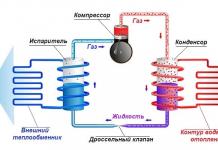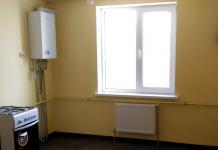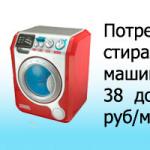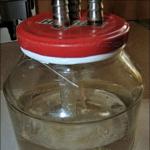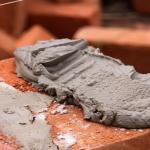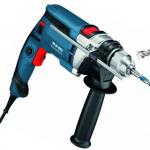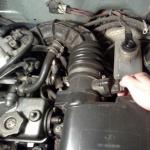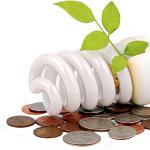We cannot imagine modern life without home appliances. Especially without a washing machine, which saves a lot of our time and effort.
But we have to pay for everything, and for electricity we receive impressive bills. You need to figure out how much electricity the washing machine consumes.
How much does laundry cost to the consumer
The electricity consumption of a washing machine is a variable and not constant figure. It depends on the selected washing mode, type of material and weight of laundry. The average power of modern washing machines is from 0.5 to 4 kW of electricity.
Of course, the whole world is striving to save natural resources, so class A washing machines are more often used, which consume from 1 to 1.5 kW / h.
If you do laundry three times a week for only two hours, then you consume between 24 and 36 kWh per month. Let's calculate how much clean clothes cost us? In Russia, there is a complex scheme for paying for electricity. It takes into account the region of residence, place of residence (city or village). Separate tariffs for the urban population living in premises equipped with stationary electric stoves. For the Moscow region, the one-rate tariff is differentiated by two zones of the day, 4.60 rubles / kWh during the day, and 1.56 rubles / kWh at night.
Thus , 
- If you use a washing machine during the day, then you spend from 110 to 166 rubles per month, and about 4-5 rubles a day.
- If you wash at night, then from 38 to 57 rubles a month.
Remember, laundry only three times a week!
What does the power label say?
When buying a washing machine, carefully study the technical specifications of the product. Pay attention to the power class of the product.
The year 1992 is significant in that the European Community adopted the famous Directive 92/75 / EEC, according to which manufacturers of household appliances began to be required to stick a label of a certain type on it, where energy consumption classes were indicated with different letters and colors.
Energy consumption kWh/kg:

The exact power consumption of the washing machine can be found in the user manual. You will know what you are paying for. Do not think that class A and B washing machines are not good enough. They wash very high quality, but innovative technologies save energy and your money. Category G machines are used very rarely and are considered unprofitable.
When washing, the machine must be loaded with laundry, according to the instructions, underweight and overload reduce the efficiency and economy of washing.
The power consumption of the washing machine is determined by the class, it implies information on the amount of electrical energy consumed during one cycle of the procedure in case of maximum load.
Subtypes of machine energy consumption
Based on the specified information, they are guided, estimating the efficiency of the unit. It is possible to obtain information by subtracting the corresponding marking located on the body of the unit. Invented by Europe 7 levels of energy consumption, denoted by labeling in Latin letters: A; IN; WITH; D; E; F; G. A plus is added to aggregates that exceed the skill limits of the standard.
- Units A are extremely economical, equipment of subspecies A requires 0.17 - 0.19 kWh.
- The consumption of a class B washing machine varies between 0.19 and 0.23 kWh.
- Devices of the type C 0.23 - 0.27 kWh spend a little more resources.
- Household appliances of subspecies D belong to the economical category, the level of "fence" varies between 0.27 - 0.31 kWh.
- Devices demonstrating E-F indicators are characterized by increased demands, the consumption level is 0.31–0.35 kWh, 0.35–0.39 kWh, respectively.
- Let's call class G devices uneconomical, they are able to "take" more than 0.39 kWh, an extremely large amount, unjustifiably.
- The antipode, the complete opposite, is the technique of category A +. "Occupies" less than 0.17 kWh, ensuring the competitiveness of products.

How much a washing machine consumes is determined by laboratory research, and the appropriate level is assigned to the technique.
"P" value
Power, which determines the rate of energy consumption, plays a key role. Washing machines show performance in the range of 2–4 kW. High figures are due to the need to heat water, they have special requirements for connecting equipment. It is associated with restrictions regarding the current passed by the wires. The power of the washing machine is 2.2 kW, the current consumption is 10 A. The throughput of copper wires is 14 A / mm 2, the parameter for aluminum wiring is 10 A / mm 2. The device, which consumes 2.2 kW, is connected, having previously calculated the cross section of the cores.

If the P of the technique exceeds the cable capacity, you will need to convert the figure to amperes using the formula: N (kW) × 4.35 \u003d A. Empirically it looks like this: 4 kW × 4.35 \u003d 17.5 A. Divide the result by the number of square millimeters, above. Compare relevant information. We conclude: connecting a machine with power
It is carried out using an aluminum wire with a core cross section of 2 mm 2 or a copper wire with a cross section of 1.5 mm 2.
Ratio of maximum power and energy
Now consider the ratio of the maximum required power to the energy costs of the cycle. The largest
The unit ranges from 2.15–2.3 kW. At the maximum setting of the physical value, the consumption is 0.94-0.95 kWh. The indicators of devices of classes B, C are identical. The power consumed by the washing machine rarely exceeds 2.2 kW, allowing you to count on resource consumption of 0.9 kWh. Cardinal differences are felt in the case of equipment belonging to subspecies D in this case, the “max” power level can also be 2.2 kW. The consumption reaches 5.2 kWh, which is extremely high.
Calculation of electricity consumption based on the power of the device
What do the installations mean for the average consumer in terms of the number of kilowatts needed during the month. The following simple scheme will help to simplify the understanding of the issue: 1000 Wh \u003d 1 kWh. In other words, the device has the largest
4000 W, for 1 hour of work will consume 4 kWh of electrical energy. Measurements of the required amount
One cycle conditional. The consumer is informed how much energy the device will consume, operating for an hour, heating water to a temperature of 60°C.

Therefore, the power consumption of a washing machine is determined by additional factors:
- fabric type;
- water temperature;
- number of turns;
- drum load.
If it is indicated on the unit: “takes” 0.94 kWh, this is how much the device will use during an hour of operation at a water temperature of 60 ° C, fully loaded with cotton fabrics. If the procedure is carried out at a temperature of 30 ° C, other things being equal, 0.47 kWh is spent.
Conclusion
The energy consumption of the washing machine is directly determined by the maximum power, the actual electricity costs are determined by the operating conditions of the equipment. Information concerning limit value
Consumption under standard conditions (cotton fabric; t=60°C), marked with a special sticker. Based on the information provided, the consumer will choose the optimal mode of operation that meets the requirements regarding the quality of the procedure, the need for electrical energy. Proper use of information will save money on the maintenance of the machine, help optimize the family budget. Focusing on the numbers of the sticker, making the right choice, acquiring an acceptable technique for washing clothes.
To choose the right model of automatic machine for yourself, it is worth considering several mandatory criteria. Many consumers, choosing this type of household appliances, first of all pay attention to the drum loading volume and the availability of the necessary washing modes. Not the last role should be played by the power of the washing machine. After all, it is on this category that the consumption of electricity spent during washing depends. By making the right choice and following certain rules for using the device, you can significantly save on utility bills.
How to determine the power of the washing machine when buying?
Each model has its own power consumption class. It is assigned after testing equipment in the laboratory. For washing machines, this is the number of kW / h per kilogram of loaded laundry. The energy efficiency scale has its own generally accepted designations: "A", "B", "C", "D", "E", "F", "G". The best class "A" can be supplemented with special "+" signs, which indicate the minimum energy consumption.
When buying, first of all, you should pay attention to the sticker. As a rule, it is located on the front side of the case or in the device passport. It contains all the information on the electricity consumed during operation.

If it is not possible to independently determine the class of household appliances, a sales consultant will help you find out the power of the washing machine in kW. Most often today there are machines of the class "A", "A +", "A ++".
What elements of the washing machine affect its power?
To determine how much electricity will be consumed during washing, it is worth figuring out what exactly it is for.

The washing machine consists of the consumed electricity of such components as:
- Engine. He is responsible for the rotation of the drum. The more revolutions per minute, the higher the power consumption. Also, the power of the engine of the washing machine depends on its type. Asynchronous, which were used in older models, are almost never found today. Their power was no more than 400 watts. Collector motors, most often found in modern models, as well as brushless (inverter) motors that are directly attached to the drum (used by LG) consume up to 800 watts, depending on the washing mode and the selected program.
- Heating element (TEN). It accounts for most of the total electricity consumed, since modern models are connected only to cold water and kW are spent to heat it to the desired temperature. Today, washing machines use heating elements, the power of which reaches 2.9 kW. depends on the selected program and wash cycle. The heating element may not consume electricity at all, for example, during the rinsing or spinning process, and its power will be used to the maximum to heat water up to 90˚ C.
- Pump. It pumps out the water used during different wash cycles. It has up to 40 watts.
- Washing machine control system. More electricity will be consumed in washing machines with electronic control type (where there are screens), up to 10 watts. But even mechanical control requires up to 5 watts (various light sensors, programmer, control buttons, etc.).
Is it only the power of the device that affects the consumption of electricity?
It is important to consider the operating conditions. As you can see, the largest power consumption is the electric motor of the washing machine and its heating element. But in the aggregate, energy consumption depends on the selected program, washing modes, drum loading, as well as on the condition of the components.
What other factors affect the energy consumption during washing?

The power consumption of the washing machine is the main, but not the only indicator that you should rely on when calculating the kW spent on the washing program. In addition to washing programs that have different temperatures, energy consumption also depends on:
- fabric type. As a rule, the choice of the program depends on it. Also, different materials have different weights when wet.
- Water temperatures. Although all modern models are connected to cold water, its temperature, especially at different times of the year, is different.
- The number of turns. This indicator affects the energy expended by the engine of the washing machine.
- Degrees of loading of a drum. Modern models with intelligent control are able to calculate the weight of the laundry loaded into the drum and collect the appropriate amount of water. Otherwise, no matter how many things are loaded into the machine, it will consume the amount of water determined by the program.
How to save electricity?
The kW consumption during washing is affected not only by the power of the washing machine, but also by the way it is operated. To save on utility bills, you should follow a few simple rules:
- Try to load the drum completely if the model does not provide for intelligent control. Thus, with each wash, you can save 10-15% of wasted energy.
- Choose a washing program wisely. For example, it is better to wash lightly soiled items in a quick wash at 30˚ C than on a Cotton program at 60˚ C.
- Clean the heating element from scale. Once every six months, run the "Cotton 60˚ C" program without linen, after laying down the descaling agent.
Conclusion
In kW, you can find out when buying, paying attention to the colored sticker on the front side of the housing of household appliances.

It can be from 2 to 4 kW. There is a special scale of energy efficiency, which divides all electrical appliances into classes. The most economical - "A" and "B" class. During operation, it is important to understand that in order to calculate the energy consumed, it is not enough to know the power of the washing machine, it is necessary to follow certain rules that will help save the cherished kW.
The power of washing machines can be different. To determine the exact amount of kW consumed by the washing machine, you need to read the information on the label of household appliances. Usually the manufacturer glues this sticker on the body of the machine. You can find out information about the power of the washing machine if you clarify which energy consumption class household appliances belong to.
What is electricity used for?
The electricity consumption of household appliances such as a washing machine is not constant, but a variable figure. It all depends on the specific washing mode, on the amount of laundry and, of course, on the type of material. The average power of a washing machine can reach 4 kW. Today in the world they are trying to save resources, so they are trying to use more household appliances that belong to class “A”. The power consumption of such equipment can reach 1.5 kW / h.

If you do laundry about three times a week for about 2 hours, the amount of electricity consumed can reach 36 kWh per month.
Consumption by class
Classes E, F, G were before. Modern manufacturers with such energy classes do not produce washing machines.

When conducting laboratory tests, experts use washing at temperatures reaching 60 degrees. Cotton linens are used as washable items. The washing drum is loaded to the maximum. All calculations that determine the energy efficiency class are based on this wash.

Factors
Many different factors affect the number of kilowatts consumed by a washing machine.
- Service life of household appliances. That is, the more the washing machine works, the more it accumulates formations on the heating element. Such formations significantly complicate the operation of the machine and the process of heating water, respectively increasing power consumption;
- The type of clothing and fabric also greatly affects the power consumption of the washing machine. The thing is that wet fabric differs from dry in weight, respectively, requires different electricity consumption;
- The workload of household appliances greatly affects the consumption of electricity. The calculation of the consumed amount of electricity is taken from the calculation of one kilogram of laundry, therefore, the more you load the drum, the more power consumption the washing machine needs;
- The washing program also affects the electricity consumption. It also talks about the temperature that is necessary for washing. High temperatures will require a lot of electricity. A long washing process increases the number of kilowatts consumed.

How to determine power?
First of all, you should understand which parts of household appliances consume electricity:
- Electric motor. This main element of the washing machine is responsible for creating the necessary rotations of the drum. The main types of motors that are used in the production of washing machines include a direct drive motor, an asynchronous motor, and a commutator motor. The average amount of power consumed will range from 400 to 800 watts, that is, from 0.4 kW to 0.8 kW. By the way, the normal washing mode consumes less electricity than the spinning process.
- A heating element responsible for heating water to the required temperature. This part of the washer also creates a fully automated drying/washing process. The quality of washing depends on the choice of temperature. For example, when rinsing in cold water, the heating element does not turn on at all, but during washing at 90-95 degrees, the heating element works to the maximum. Each built-in heating element in the washing machine has its own installed power, which can reach 2.9 kW. Accordingly, the higher the power, the faster the water will heat up.
- pump or pump. This important part of the washing machine is designed for the process of pumping out water, which can take place at various stages of washing. Pumps generally consume up to 40 watts.
- The control panel, which includes radio components, various light bulbs, the necessary starting capacitors, various sensors, a special programmer and an electronic module, can consume up to 10 watts.

How to save?
By the way, in addition to the above factors, other aspects also affect the amount of electricity consumed. For example, the unjustified consumption of electricity consumed by a washing machine.
- First, the unjustified use of the dryer. It is necessary to try on windy sunny days to dry clothes on the street, thereby saving energy consumption.
- Secondly, it is necessary to choose the right washing mode, since An inaccurately selected program can use up 30% of extra kilowatts.
- Third, you need to fully load the drum, because if this is not done, 10-15% more electricity is consumed. Accordingly, it is better to load one full wash than several small ones.
- And the most important thing, the washing machine should be unplugged immediately after washing.

Washing machines - how they facilitate the washing process, when you had to do everything by hand, wash, rinse and then wring it all out, now everything is much easier, to get fresh clean things you just need to put them in the machine, everything else she will do herself. Of course, everything is fine, but electricity tariffs are rising and we often think about how much electricity household appliances spend, is it possible to somehow save on this.
How much electricity is consumed
All machines, depending on the brand, model and technical characteristics, consume electricity in different ways. The power consumption affects the power consumption. The higher it is, the more the machine consumes when washing. But the total consumption depends on what washing modes are available. The less time the machine works and the lower the temperature of the water in which things are washed, the lower the energy consumption.
On average, most automatic machines belong to energy class A This shows that energy is being used sparingly. Also classes A +, A ++ and B. The main indicator that determines how much electricity the machine will spend is energy consumption per cycle.
The cycle is the cost from the start of the wash to the end of the spin cycle.
On average, machines are consumed per cycle - from 0.8 to 1 kilowatt.
At different moments of washing, the machine consumes electricity from 300 watts to 2 kW.
Let's calculate the costs:
Let's say we do laundry 3 days a week, load 3 loads a day. In total, we get 9 washes per week.
36 washes per month. Knowing that the machine consumes about 1 kilowatt per wash, we get an approximate consumption of 36 kilowatts or 36,000 watts per month. At the cost of 1 kilowatt 4 rubles we get:
- For one wash we spend 4 rubles.
- For 1 hour, a washing machine consumes on average ~ 1.5 to 2 kW of electricity.
- For 1 month 36 * 4 = 144 rubles.
- For 1 year, we spend 144 rubles * 12 = 1728 rubles on laundry.
